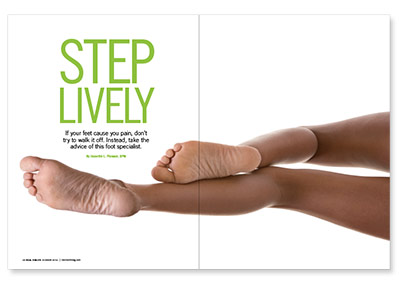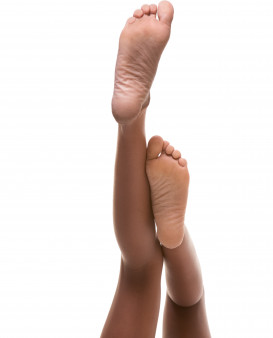
Although the foot is a complex structure made up of 26 bones, 33 joints and 200 muscles, tendons and ligaments, we often take this body part for granted. But the feet are our body’s main mode of transportation—according to the American Podiatric Medical Association, by the time we reach age 50 we’ve already logged 75,000 miles on our feet.
Feet also help us maintain our balance, absorb the shock of movement and support our body weight. That’s why, if we suffer a foot injury, it can totally affect our quality of life.
During my years in private practice as a podiatrist, I’ve seen many patients with a variety of conditions that caused their feet to hurt. In many instances, the foot pain they suffered either signaled an underlying condition or created other health problems in their lives.
Mary was an active 80-year-old woman who arrived in my office one day complaining of difficulty walking. Mary said she felt pain in her right heel when she tried to put her foot down. After I examined the sole of her heel, I found a mole in its center. The mole was asymmetric, had an irregular border, variation in color (black to dark brown) and measured 4 millimeters in diameter. Mary’s diagnosis? Melanoma, a skin cancer that can be deadly if not treated early.
Mary was perplexed she’d been diagnosed with cancer. She had been seeing an internist on a regular basis and always got a clean bill of health. But like many other people who visit their doctor for a physical exam, Mary didn’t get her feet checked. After my diagnosis, Mary underwent surgery. Doctors removed half her heel and fitted her with a heel prosthesis. The surgery saved her life.
Mary’s melanoma is an example of a foot problem that signaled a dangerous illness. But many of the stresses on our feet stem from everyday activities, such as standing and walking for long hours and wearing the incorrect type of footwear.
One common foot problem is Morton’s neuroma, an inflammation of the nerve between the third and fourth toes. This condition can cause burning and pain that feels like electric shocks. If your job requires standing and walking for hours, Morton’s neuroma could lead to balance problems as you try to relieve the pain by transferring body weight from one leg to the other.
But while you may not be able to change jobs, you can address foot pain by fitting your shoes with pads and inserts to comfort the soles of your feet. Shoe inserts may seem like a minor fix, but just this small change can allow you to do your job without wincing at every step.
Remember the hot TV series Sex and the City? “Hello lover,” coos Sarah Jessica Parker’s character Carrie Bradshaw to a pair of Manolo Blahnik stilettos in an episode of the show. Indeed, many women who love high heels feel the same as Bradshaw. They’d absolutely kill for a pair of these famous designer shoes. But let’s face it, wearing beautiful shoes shouldn’t have to include putting yourself at risk of an ankle injury.
“For 10 or so years, I literally ran in heels,” Parker told an interviewer for Net-a-Porter, an online fashion magazine. “I worked 18 hour days and never took them off.”
Is it any surprise that the superstar developed foot problems? When Parker went to a doctor after the cheap, plastic-soled shoes she wore for a movie role caused her to slip and twist her ankle, she said he told her that she’d created a bone in her foot that shouldn’t have been there. (By the way, plastic shoes are always bad news. Unlike shoes made of leather, they don’t allow your skin to breathe.)
Like Parker, many women suffer from foot problems because they wear high-heeled shoes. When Grace, a secretary friend of mine, told me she couldn’t switch from high heels to flat shoes, I was shocked to learn why. Grace had worn high-heeled shoes for so long that she’d shortened the muscle in the back of her leg. As a result, she could never put her heels flat on the ground.
But wearing high heels isn’t the only source of discomfort that can lead to foot deformities. Injuries also result when you jam normally square-shaped feet into pointy-toed shoes. Crowding the feet into too-small shoes can cause hammer, claw or mallet toes. This happens when the toes bend into irregular shapes. What’s more, squeezing the feet into shoes that don’t properly fit can also result in corns, calluses and pain that will have you limping through life.
In addition, ill-fitting shoes may also cause ingrown toenails, fungal infections, bunions, pain under the ball of the foot, stress fractures and pain under the big toe. Just kick this thought around for a minute: If your tootsies hurt, you will be unhappy too.
This is why it’s especially important to protect the feet with well-fitting, supportive shoes when you exercise. High-impact activities such as jogging require really good shoes to avoid corns, calluses, blisters, muscle cramps and ankle injuries.
But sometimes a foot disorder doesn’t cause the feet to hurt. Helen, another patient, came to see me for a pain in her lower back. After an examination, I learned one of her legs was shorter than the other. The difference was just enough to cause Helen back pain. To address the problem, I had Helen fit the shoe she wore on the shorter limb with a lift. Once she stood without any height difference, her back pain resolved.
In addition, systemic diseases such as diabetes, peripheral artery disease, ulcers, gout, neuropathy and arthritis can also affect the feet. Also, because the feet are further away from the heart, circulation problems can occur.
Over the years, I observed that older women seem to have a lot more foot problems than younger women. But a study done by the National Institutes of Health on this issue couldn’t explain why. Still, you don’t need findings to know that your feet must last a lifetime. That means like any other part of your body your feet need attention and regular examinations. Whenever you go for your annual physical, be sure the doctor checks your feet—it might very well alert you to an underlying health problem.
In addition, if you have a systemic disease, such as diabetes, it is especially important to get your feet checked by a podiatrist.
When it comes to your health, don’t take a chance by doing it yourself. Many common foot problems, such as nail fungus, can put you at risk of other serious infections, especially if your immune system is not functioning to provide maximum protection.
For example, people with diabetes, leukemia and AIDS, or those who’ve received a transplanted organ, are particularly at risk of more severe illnesses if they have nail fungus or some other minor foot injury.
A fungal infection of the nail or skin (athlete’s foot) creates cracks and other openings that may invite bacteria to invade the body and cause infections elsewhere. (Nail fungus is notoriously difficult to treat. But two promising new topical treatments—efinaconazole and tavaborole—are in various stages of the FDA approval process.)
In general, you can take many steps to care for your feet that don’t require a visit to the doctor.
Most important, always inspect your feet and don’t let them become a forgotten body part. Keep the skin of your feet hydrated (but make sure the area between the toes stays dry to avoid inviting a fungal infection); trim nails straight across; and wear sandals when in moist, warm areas such as at pools and showers located at the gym.
Remember, for overall good health, treat your feet well. Simply put, this means don’t neglect your feet and allow minor foot problems to become major disabilities.







Comments
Comments